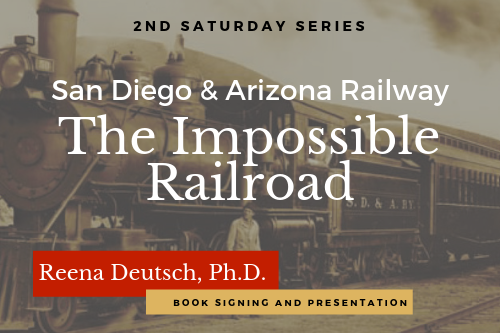Members Only: By Land and By Sea
San Diego Archaeological Center 16666 San Pasqual Rd., Escondido, CA, United StatesLocation: San Diego Archaeological Center Cost: Free Center members are invited to a preview of the new exhibit, By Land and By Sea, which explores theories about who, when, and how early peoples came into the New World and into Southern California. Enjoy food and drink in the museum hall, hear a Curator Talk on the featured exhibit, and explore the museum with our new Cuseum web tour app.
Archaeology of the Coronados Islands
San Diego Archaeological Center 16666 San Pasqual Rd., Escondido, CA, United StatesLocation: San Diego Archaeological Center Cost: Free Despite their attractiveness to early human migrants and maritime foragers, small islands often are overlooked in archaeological and historical ecological investigations. Along Alta and Baja California, the Channel Islands and Isla Cedros have been the focus of extensive and intensive archaeological investigations. Even with the wealth of data from islands to the north and south, the Coronados Islands, a small set of four islands off the northwestern Baja California coast, have been the subject of very little scientific archaeological research. Joseph McCain will present his findings after an initial field season was completed in 2016. This research produced the first radiometric dates from the Coronados Islands, built an initial settlement chronology and occupational history, identified several prehistoric sites with high research potential, and laid the foundation for future archaeological and historical ecological studies of the island group.
2nd Sat: Murder and Mayhem
San Diego Archaeological Center 16666 San Pasqual Rd., Escondido, CA, United StatesEarly twentieth-century San Diego was growing fast, and the officers sworn to protect the city encountered more than their fair share of wily lawbreakers. From a shootout with a lone gunman in Mission Hills to gunfights with a gang of bank robbers that involved enthusiastic bystanders hoping to assist, detectives and patrolmen alike tried to maintain the peace. They encountered unexpected bodies, confronted car thieves and pursued criminals through neighboring states and into Mexico. Join author Steve Willard as he unearths stories directly from the case files of the early San Diego Police Department. About the Author A San Diego resident since 1977, author Steve Willard joined the SDPD in 1985 and has worked patrol, crime prevention/public affairs, the detective bureau, the Traffic Division and management. He became a charter member of the San Diego Police Museum in 1997 and is the historian of the San Diego Police Officers Association. A reoccurring columnist in two law enforcement periodicals, Steve has authored three books on SDPD history and has consulted on a number of other historical projects. Date: Saturday, May 11, 2019 Time: 11 AM Location: San Diego Archaeological Center Cost: Free
2nd Sat: The Impossible Railroad
San Diego Archaeological Center 16666 San Pasqual Rd., Escondido, CA, United StatesIn the early 1900s, San Diego was a growing and thriving city, but with no rail transportation eastward. Spearheaded by John D. Spreckels, with his persistence and money, a railroad was constructed that engineers warned would be impossible to build. Starting in San Diego, the “Impossible Railroad” snaked through brutal mountain and desert terrain to connect with the transcontinental Southern Pacific in El Centro. It took 12 challenging years to build, but the 1919 completion was widely celebrated. This November is the 100th anniversary of the completion of the San Diego and Arizona Railway which still operates along parts of its 148-mile route. Author Reena Deutsch will give an account of the line’s dramatic history through vintage photos and gripping narration. About the Author After stumbling upon old railroad tracks in our local desert, Dr. Reena Deutsch researched the colorful history of John Spreckels’ San Diego and Arizona (Eastern) Railway and has given dozens of lectures and wrote a book on it. Prior to retirement, Dr. Deutsch was a UCSD medical researcher. She currently serves as Board member for the Anza-Borrego Desert Natural History Association and Balboa Park’s San Diego Model Railroad Museum. This year, she is collaborating with the Pacific Southwest Railway Museum Association to celebrate the 100th anniversary of the completion of the San Diego and Arizona Railway. Date: Saturday, June 8, 2019 Time: 11 AM Location: San Diego Archaeological Center Cost: Free
A Life in San Diego Archaeology
San Diego Archaeological Center 16666 San Pasqual Rd., Escondido, CA, United StatesJoin the Center for a reception and presentation by local archaeologist, professor, and author Dr. G.Timothy Gross. Gross volunteered on his first archaeological projects as a high school student in 1968, and although he has worked outside San Diego, he has been involved in local archaeology ever since. In this talk he will reflect on the changes that have happened in the last 50 years in how archaeology has been done and by whom. He will look at what we have learned and what ideas we have discarded, and he will address the ever-changing political climate of local archaeology. A tour of the Center will be offered following the presentation. Date: Saturday, November 9, 2019 Time: 12 PM to 3 PM (Presentation at 1 PM) Location: San Diego Archaeological Center Cost: Free
Shrouded Heritage
San Diego Archaeological Center 16666 San Pasqual Rd., Escondido, CA, United StatesTen years ago, Thomas Holm read Scott O’Dell’s novel Island of the Blue Dolphins with his fourth-grade daughter. That experience led to him to research California’s indigenous mariners, including the “Nicoleño” of San Nicolas Island, which is the real setting of O’Dell’s book. That ten year journey, from elementary school field trip, to claims of improprieties, to the enactment of new preservation laws, will be addressed by Holm as he presents his new book entitled, Shrouded Heritage: Island of the Blue Dolphins. Holm sets out to learn the truth about California’s ancient island-dwelling People, especially the real-life woman fictionalized as Karana in Scott O’Dell’s beloved novel Island of the Blue Dolphins. That endearing soul became the last of her kind after witnessing the bloody massacre of her tribe. She then suffered 18 years of isolation on her cold and merciless island. This investigation of her life and the legacy of her People inadvertently triggers a battle among academics and Indigenous Peoples with world-wide implications. Woven together within this saga are data from church records, court papers, ship logs, and dozens of other historic and “scientific” documents. Likewise, and with equal reverence, included are oral accounts, traditional songs, and religious beliefs of tribal elders. This uniquely inclusive approach provides the source of new information about the real “Island of the Blue Dolphins” and its remarkable heritage. Also included in Holm’s presentation will be exclusive photos of unique artifacts, archeological excavations and extraordinary scenery from San Nicolas Island. About the Author Thomas Holm is an author, archaeological researcher, environmental activist, and long-distance paddler. His research has focused on the ancient maritime cultures of the Southern California Bight, including those of the Channel Islands. He teaches Marine Archaeology and Preservation at California State University, San Marcos and has made numerous solo passages on a stand up paddleboard from the mainland to the Channel Islands to research early oceanic trade routes. Signed copies of Holm’s book will be available for purchase and proceeds will help establish the M/V Conception Memorial Garden on Santa Cruz Island to honor 34 people recently killed during a boat fire. Date: Saturday, February 8, 2020 Time: 11 AM Location: San Diego Archaeological Center Cost: $2 (museum admission included; pay at door); Members Free

